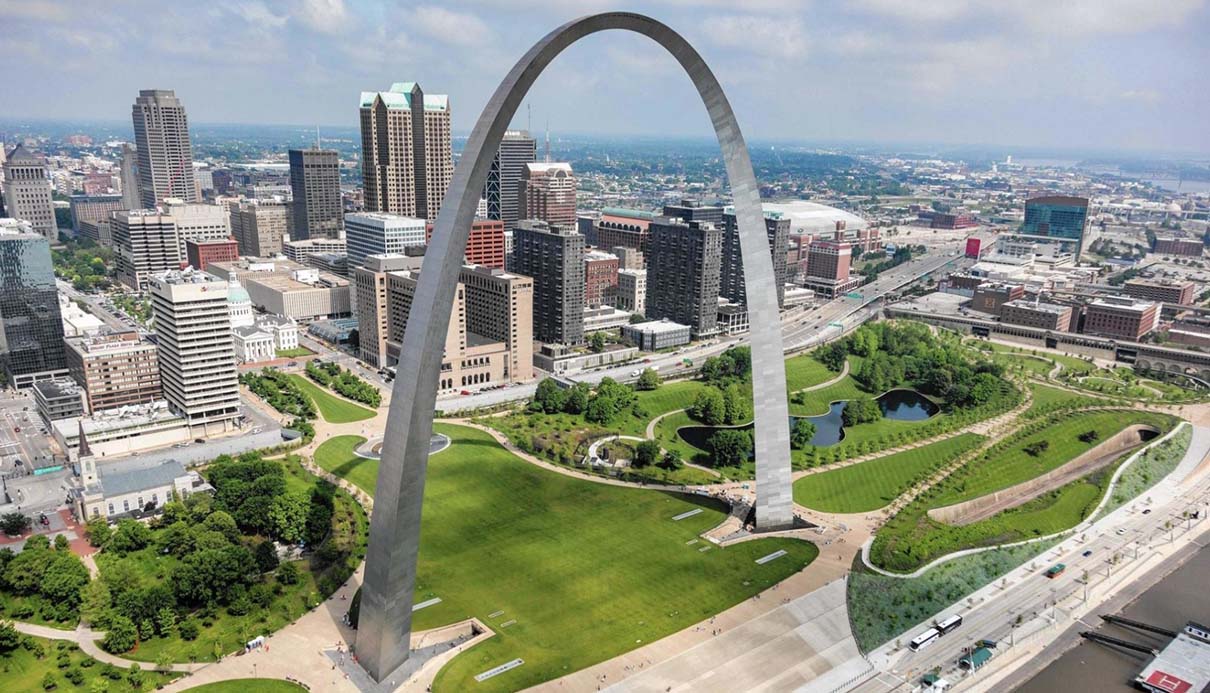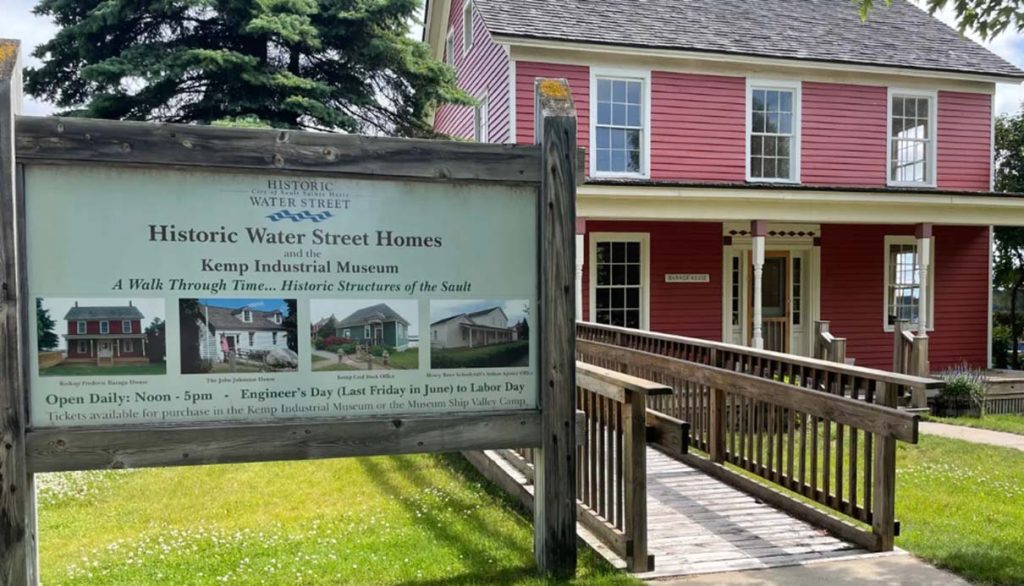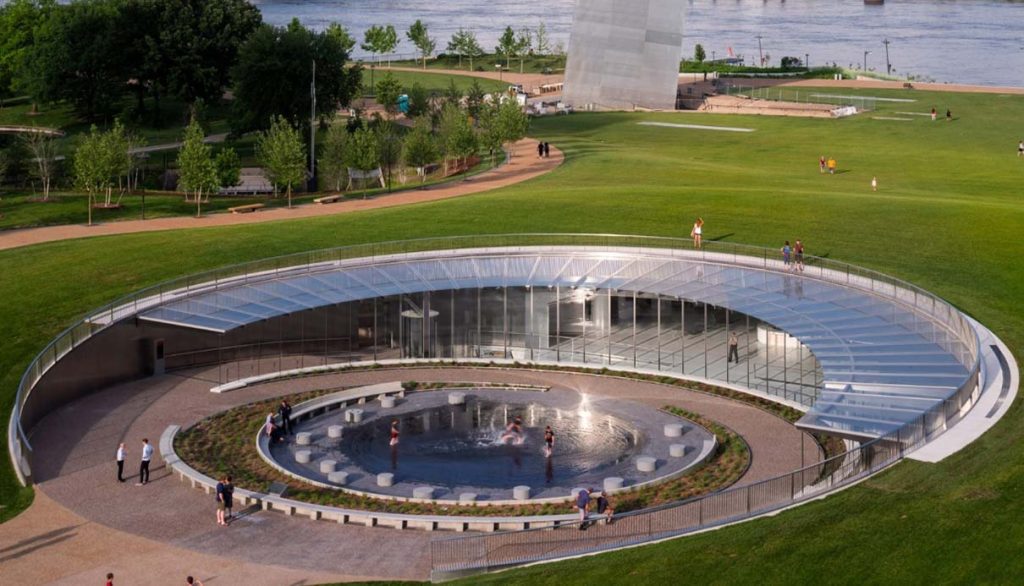A Historical Odyssey in St. Louis: Immersed in Time and Tradition

Often referred to as the “Gateway to the West,” St. Louis, Missouri is a city filled with historical, cultural, and architectural wonders. Nestled along the majestic Mississippi River, this Midwestern gem offers visitors a unique opportunity to step back in time and immerse themselves in a rich historical narrative while enjoying today’s vibrant traditions. I embarked on a fascinating journey to St. Louis, ready to discover its historical treasures and uncover the stories that shaped this extraordinary city. Next, I’ll take you on a detailed tour of St. Louis, share personal experiences, offer practical advice, and highlight the best ways to make the most of your time and resources. Prepare to be transported through centuries of history, architecture, and culture as we travel through the charming streets of St. Louis.
Gateway Arch National Park – A Monument to Innovation
Our journey begins at the iconic Gateway Arch National Park, an architectural marvel that stands as a symbol of St. Louis’s historical and pioneering spirit. This colossal stainless steel arch, soaring to a height of 630 feet (192 meters), offers visitors not only breathtaking views but also a profound connection to America’s westward expansion.
The Gateway Arch – A Monument of Progress
Standing at the base of the Gateway Arch, I was immediately struck by its sheer size and gleaming metallic surface, which seemed to stretch endlessly into the sky. The arch, often dubbed the “Gateway to the West,” was designed by architect Eero Saarinen and commemorates the westward expansion of the United States. Its bold, modernist design is a testament to human ingenuity and engineering excellence.
To fully appreciate the arch’s magnificence, I decided to embark on the tram ride that takes visitors to its summit. The tram cars, which resemble small capsules, offer a unique and slightly claustrophobic experience as they ascend within the arch’s curved legs. It felt as though I were being transported to the heavens themselves.
Upon reaching the observation deck, I was greeted by a panoramic view that left me utterly speechless. To the east, the Mississippi River flowed gracefully, while to the west, the cityscape sprawled out beneath me. The Gateway Arch had transformed into a literal gateway to the world, offering a glimpse of the vast landscapes that early American pioneers once sought to conquer.
Exploring the Museum of Westward Expansion
After descending from the arch, I took some time to explore the Museum of Westward Expansion, located beneath the monument. This engaging museum delves deep into the history of westward expansion, offering visitors a comprehensive understanding of the challenges, triumphs, and cultural changes that shaped America during this pivotal era.
The exhibits within the museum are both educational and immersive, featuring artifacts, dioramas, and interactive displays that bring history to life. One notable section is dedicated to the Lewis and Clark Expedition, which departed from St. Louis in 1804 on a mission to explore the newly acquired Louisiana Territory. The museum also touches on the impact of westward expansion on indigenous peoples and the struggles they faced.
Practical Information for Visitors
Visiting the Gateway Arch National Park is an enriching experience that can be accomplished in a half-day or full-day excursion. Here are some practical tips to enhance your visit:
- Ticket Reservations: To secure a tram ride to the top of the arch, it’s advisable to make reservations in advance, especially during peak tourist seasons.
- Accessibility: The park is wheelchair accessible, with ramps and elevators available for those with mobility concerns.
- Exploration Time: Allocate at least 2-3 hours for your visit to ensure ample time for the tram ride, museum exploration, and taking in the panoramic views.
- Visitor Center: Start your journey at the Visitor Center, where you can learn more about the park’s history and orientation.
The Old Courthouse – A Witness to History
Adjacent to the Gateway Arch National Park stands the historic Old Courthouse, a splendid architectural gem that has borne witness to significant moments in American history. This elegant courthouse played a central role in shaping the nation, including the famous Dred Scott case, which had far-reaching implications on the road to the American Civil War.
A Glimpse into History
Stepping through the grand entrance of the Old Courthouse felt like a journey through time. The soaring dome, reminiscent of the United States Capitol, and the intricate details of the interior transported me to an era when this building was at the heart of legal and political discourse.
The Old Courthouse is not merely an architectural marvel; it’s also a place where history unfolded. It was here, in the Courtroom where I stood, that the landmark Dred Scott v. Sandford case was argued in the 1850s. This infamous case ultimately denied Dred Scott, an enslaved African American, and his wife their freedom, deepening the tensions that led to the American Civil War.
Guided Tours and Exhibits
To gain a deeper understanding of the Old Courthouse’s historical significance, I decided to join a guided tour. Knowledgeable guides led me through the courthouse, providing insights into its role in American history, its remarkable architecture, and the stories of those who passed through its doors.
One of the most captivating aspects of the Old Courthouse is the immersive exhibits that shed light on the Dred Scott case and its repercussions. These exhibits not only delve into the legal aspects of the case but also explore the human stories behind it, making history come alive.
Practical Information for Visitors
Here are some practical considerations for your visit to the Old Courthouse:
- Guided Tours: Guided tours are available and are highly recommended for a more comprehensive understanding of the courthouse’s history.
- Visitor Center: Start your visit at the Visitor Center, where you can obtain information about tour times, exhibits, and the history of the courthouse.
- Admission: Entry to the Old Courthouse is free, making it accessible to all visitors.
- Exploration Time: Plan to spend 1-2 hours exploring the courthouse and taking in the exhibits.
The Soulard Neighborhood – A Cultural Journey

Our exploration of St. Louis’s historical treasures takes us to the charming Soulard neighborhood, a place where the city’s French heritage and vibrant culture blend seamlessly. Nestled just south of downtown St. Louis, Soulard offers a delightful blend of historical architecture, lively markets, and an authentic taste of the city’s soul.
Stepping into the Past
Wandering through the streets of Soulard felt like a step back in time. The neighborhood’s historic charm is evident in its cobblestone streets, well-preserved 19th-century townhouses, and gas lamps that cast a warm glow as evening approaches.
One of the most captivating aspects of Soulard is its strong French influence, evident in the architecture and the neighborhood’s name itself, a nod to Antoine Soulard, a surveyor who worked with Auguste Chouteau, the co-founder of St. Louis. This French heritage is celebrated annually during the lively Mardi Gras festivities, which draw visitors from near and far.
Soulard Market – A Culinary Journey
The heart of Soulard is undoubtedly the Soulard Market, one of the oldest farmers’ markets in the United States. This bustling marketplace is a sensory delight, with colorful stalls brimming with fresh produce, artisanal goods, and delectable street food.
My visit to the market was a culinary adventure. I couldn’t resist trying local specialties, including gooey butter cake, a sweet treat that’s a St. Louis tradition. However, the highlight of my culinary journey was indulging in savory beignets paired with chicory coffee, a quintessential New Orleans experience that has found a home in St. Louis.
Immersing in the Neighborhood
One of the joys of visiting Soulard is immersing yourself in the local culture. I strolled through the streets, admiring the well-preserved historic homes, many of which have been lovingly restored. The neighborhood’s community vibe was palpable, with residents tending to their gardens and engaging in friendly conversation.
Soulard’s lively atmosphere is not limited to the market; the neighborhood is also known for its vibrant nightlife scene. The historic Soulard district comes alive with bars, restaurants, and live music venues, making it an ideal spot for an evening of entertainment.
Practical Information for Visitors
To make the most of your visit to the Soulard neighborhood, consider the following tips:
- Market Hours: The Soulard Market is typically open Wednesday through Saturday, with varying hours. Plan your visit accordingly to catch the market at its liveliest.
- Local Eateries: Don’t miss the opportunity to dine in local eateries and savor St. Louis’s unique cuisine, such as St. Louis-style pizza and barbecue.
- Walking Tour: Consider joining a walking tour of Soulard to gain insights into its history and architecture. These tours are often led by knowledgeable guides who can provide fascinating anecdotes about the neighborhood.
- Festivals and Events: Check if there are any local festivals or events taking place during your visit, as these can provide a unique cultural experience.
The Cathedral Basilica of St. Louis – A Masterpiece in Mosaics
Our journey through St. Louis’s historical treasures continues with a visit to the Cathedral Basilica of St. Louis, a place where art, spirituality, and history converge. This architectural gem is renowned for its breathtaking mosaics, making it a must-see attraction for those seeking to be both inspired and immersed in the city’s cultural heritage.
A Stained Glass Wonderland
Stepping into the Cathedral Basilica of St. Louis felt like crossing the threshold into another world. The grandeur of this sacred space is immediately apparent, with its lofty arches, intricate stained glass windows, and a sense of tranquility that envelops visitors.
What sets this cathedral apart, however, is its remarkable collection of mosaics. Covering the interior from floor to ceiling, these mosaics are composed of over 41 million pieces of glass, meticulously arranged to depict scenes from biblical narratives and religious history.
As I gazed upward at the dome, I couldn’t help but be awestruck by the intricate details and vibrant colors that adorned it. The mosaics were a testament to the dedication and craftsmanship of the artisans who brought this masterpiece to life.
Exploring the Mosaics
To fully appreciate the splendor of the Cathedral Basilica’s mosaics, I embarked on a self-guided tour, available to all visitors. The tour allowed me to explore the various chapels and sections of the cathedral, each adorned with its unique mosaic theme and narrative.
One of the highlights of the tour was the “Life of St. Louis” mosaic series, which vividly portrayed key moments in the life of King Louis IX, the patron saint of the city. These mosaics offered not only a glimpse into the history of St. Louis but also a deeper connection to the city’s namesake.
The Cathedral Basilica’s mosaics are not limited to religious themes. They also include depictions of St. Louis’s diverse cultural heritage, showcasing the contributions of various immigrant communities to the city’s growth and identity.
Practical Information for Visitors
To enhance your visit to the Cathedral Basilica of St. Louis, consider the following tips:
- Entry and Photography: Entry to the cathedral is free, and photography is permitted. Donations are encouraged to support the preservation of this architectural treasure.
- Guided Tours: While self-guided tours are available and informative, guided tours led by knowledgeable docents can provide deeper insights into the history and symbolism of the mosaics.
- Mass Schedule: Check the cathedral’s schedule for Mass times and special events, as attending a service can offer a unique spiritual experience.
- Quiet Reflection: The cathedral provides a serene atmosphere for quiet reflection, making it a tranquil escape from the bustling city.
Historic Neighborhoods – A Stroll through Time
St. Louis is a city dotted with historic neighborhoods, each possessing its unique character and a trove of stories waiting to be uncovered. These neighborhoods offer a glimpse into the city’s past and provide an opportunity to explore its architectural heritage, diverse communities, and cultural traditions.
Lafayette Square – Victorian Elegance
Lafayette Square is a neighborhood that effortlessly combines Victorian-era charm with modern urban living. As I ventured into this historic enclave, I was immediately captivated by its picturesque streets lined with impeccably preserved 19th-century homes.
One of the standout features of Lafayette Square is the eponymous park at its center. Lafayette Park, designed in the style of a Victorian pleasure garden, offers a serene escape from the city’s hustle and bustle. I spent a leisurely afternoon wandering through the park’s pathways, surrounded by lush greenery and ornate fountains.
The architecture of Lafayette Square is a testament to the neighborhood’s historical significance. Stately mansions, adorned with intricate ironwork and picturesque balconies, stand as reminders of the wealth and elegance that characterized this area in the late 19th century.
Central West End – Elegance and Modernity
In stark contrast to the historical charm of Lafayette Square, the Central West End (CWE) is a neighborhood that seamlessly blends historic elegance with contemporary vibrancy. As I explored CWE’s streets, I marveled at the harmonious coexistence of ornate turn-of-the-century buildings and trendy shops, restaurants, and cultural venues.
One of the most prominent landmarks in CWE is the Chase Park Plaza Hotel, a grand Art Deco-style establishment that has hosted countless celebrities and dignitaries over the years. The hotel’s presence adds a touch of glamour to the neighborhood and serves as a testament to CWE’s enduring appeal.
During my visit, I made a point of exploring the streets surrounding the Cathedral Basilica of St. Louis. Here, I found a plethora of charming cafes, boutiques, and bookstores, creating an ideal setting for a leisurely day of exploration. The sidewalk cafes and tree-lined avenues invited me to take a seat, sip a cappuccino, and observe the world passing by.
Practical Tips for Exploring Historic Neighborhoods
To make the most of your exploration of St. Louis’s historic neighborhoods, consider the following tips:
- Walking Tours: Guided walking tours are often available and offer valuable insights into the history, architecture, and cultural significance of these neighborhoods.
- Local Dining: Take advantage of the culinary offerings in these areas, from cozy cafes to fine dining establishments. It’s an opportunity to savor both local and international cuisine.
- Community Engagement: Engage with locals and residents to gain a deeper appreciation for the neighborhoods’ unique character and sense of community.
- Parks and Green Spaces: Many historic neighborhoods boast beautiful parks and green spaces, providing opportunities for relaxation and leisurely strolls.
The Missouri History Museum – Navigating the Past

Our historical journey through St. Louis takes us to the Missouri History Museum, a place where the city’s diverse history comes to life. Situated within the sprawling confines of Forest Park, this museum offers a comprehensive look at St. Louis’s evolution, from its Native American roots to its pivotal role in westward expansion and industrialization.
Exploring the Museum’s Galleries
The Missouri History Museum features a series of engaging galleries that cover various aspects of the city’s history and culture. From Native American heritage to the thriving city of today, the museum’s exhibits provide a multi-faceted view of St. Louis’s past and its contributions to the broader American narrative.
As I embarked on my museum journey, I was struck by the diversity of exhibits on display. One of the first galleries I encountered focused on the pre-European history of the region, highlighting the rich cultures and traditions of Native American communities that once inhabited the area.
Another section of the museum delved into St. Louis’s role in westward expansion, including the Lewis and Clark Expedition, which departed from the city in 1804. The exhibits vividly portrayed the challenges and triumphs faced by early explorers and pioneers.
A particularly captivating aspect of the museum’s collection was its focus on the 1904 World’s Fair, a monumental event that showcased St. Louis’s grandeur during the early 20th century. The exhibits featured artifacts and memorabilia from the fair, allowing visitors to step back in time to this iconic moment in the city’s history.
Interactive and Immersive Exhibits
The Missouri History Museum goes beyond traditional exhibits, offering interactive and immersive experiences that make history come alive. In one gallery, I had the opportunity to step inside a replica of a streetcar, complete with vintage advertisements and the clanging of bells, offering a glimpse into the public transportation of yesteryear.
Another interactive exhibit allowed visitors to explore the history of St. Louis’s music scene, from the birth of ragtime to the rise of rock ‘n’ roll. I found myself tapping my feet to the rhythms of St. Louis’s musical heritage.
Practical Information for Visitors
To make the most of your visit to the Missouri History Museum, keep these practical tips in mind:
- Admission: Entry to the museum is free, making it an accessible and budget-friendly attraction.
- Exploration Time: Plan to spend 2-3 hours exploring the museum’s galleries, interactive exhibits, and special displays.
- Gift Shop: Don’t forget to visit the museum’s gift shop, which offers a selection of books, souvenirs, and locally crafted items.
- Special Events: Check the museum’s calendar for special events, lectures, and workshops that may coincide with your visit.
The Eads Bridge – A Historical Marvel
As we continue our journey through St. Louis, we encounter the Eads Bridge, a historical engineering marvel that has played a vital role in the city’s development and transportation. Spanning the Mississippi River, this bridge is not only a symbol of progress but also a stunning example of 19th-century engineering and architectural innovation.
A Bridge to the Past
Approaching the Eads Bridge, I was immediately struck by its intricate ironwork and elegant design. Constructed in the late 19th century, the bridge was a pioneering engineering achievement that connected the eastern and western regions of the United States by rail. Its completion marked a significant milestone in the expansion of the American frontier.
Walking across the Eads Bridge felt like traversing a work of art. The bridge’s ornate details, from its towering stone piers to its intricate iron lattice, spoke to the craftsmanship and attention to detail that defined the era in which it was built. It was as if I had stepped into a time capsule, transported back to a period when such engineering feats were the forefront of innovation.
Historical Significance
The Eads Bridge is not only a testament to engineering prowess but also holds historical significance for St. Louis. It played a crucial role in facilitating the movement of goods, people, and ideas during a time when the city was a bustling center of commerce and industry.
One of the most intriguing aspects of the bridge’s history is its connection to the American Civil War. During the war, the Eads Bridge was considered a strategic asset, and measures were taken to protect it from Confederate forces. This historical context added another layer of intrigue to my journey across the bridge.
Photography and Golden Hours
The Eads Bridge provides an excellent opportunity for photography enthusiasts, particularly during the golden hours of sunrise and sunset. The soft, warm light bathes the bridge’s ironwork in a golden hue, creating a picturesque setting that’s ideal for capturing its beauty.
Practical Information for Visitors
If you plan to visit the Eads Bridge, consider these practical tips:
- Walking or Biking: The bridge is accessible to pedestrians and cyclists, providing an excellent vantage point for enjoying its architectural details and river views.
- Photography: Bring your camera or smartphone to capture the bridge’s beauty, especially during sunrise or sunset.
- Historical Insights: Familiarize yourself with the bridge’s history and significance before your visit to enhance your appreciation of its role in St. Louis’s past.
Practical Tips for Your St. Louis Journey
As you plan your historical journey through St. Louis, there are several practical considerations to keep in mind to ensure a smooth, enriching, and memorable experience.
1. Duration of Your Visit
To fully immerse yourself in St. Louis’s history, culture, and architecture, I recommend dedicating a minimum of 3-4 days to your visit. This timeframe allows you to explore the city’s highlights thoroughly, all while savoring its essence at a leisurely pace.
2. Budget-Friendly Travel
St. Louis is renowned for its affordability as a travel destination. Many of its attractions, including museums and parks, offer free or budget-friendly admission. Dining in local eateries is not only a cost-effective option but also an opportunity to relish delectable, authentic cuisine.
3. Transportation Options
St. Louis boasts an efficient public transportation system, comprising buses and a light rail system. Consider purchasing a transit pass for convenience and cost savings. Alternatively, embrace the city’s walkability or rent a bicycle to take full advantage of its well-maintained bike lanes.
4. Weather Considerations
Keep an eye on the weather forecast for your travel dates, as St. Louis experiences all four seasons. Pack your luggage accordingly, bearing in mind that summers can be hot and humid, while winters may bring cold temperatures and sporadic snowfall.
5. Local Cuisine Exploration
Do not miss the opportunity to indulge in St. Louis’s distinctive culinary offerings. Sample the renowned St. Louis-style pizza, celebrated for its thin, crisp crust and distinctive Provel cheese. Delve into the world of St. Louis-style barbecue, where slow-cooked meats are generously coated in savory sauces.
Embark on Your Historical Odyssey
St. Louis is a veritable treasure trove of history, culture, and architectural marvels, beckoning travelers to unravel its rich tapestry. Whether you’re a history enthusiast, an architecture aficionado, or simply someone in search of an immersive cultural experience, St. Louis promises a journey that is both enriching and memorable.
Pack your bags, set your course, and embark on your very own historical odyssey through this captivating city. With every step, you’ll unearth a new chapter in the captivating story of America’s heartland. St. Louis, with its grand monuments, charming neighborhoods, and vibrant traditions, is ready to welcome you to a world where the past and present harmoniously coexist.
Often referred to as the “Gateway to the West,” St. Louis, Missouri is a city filled with historical, cultural, and architectural wonders. Nestled along the majestic Mississippi River, this Midwestern gem offers visitors a unique opportunity to step back in time and immerse themselves in a rich historical narrative while enjoying today’s vibrant traditions. I…
Recent Posts
- 🍽️ Mobile’s Hidden Gems: Bold Flavors on a Budget
- Culinary Delights in Chiayi, Taiwan: Unmissable Flavors and Healthy Choices
- Come Stay in Mobile for a Night: 5 Boutique Hotels You Simply Can’t Miss
- Traveling to Tainan: Uber Eats Brings You the Best Local Delicacies
- How to Avoid the Crowds and Experience the Hidden Gems of New Orleans






